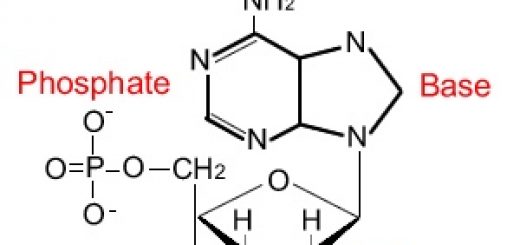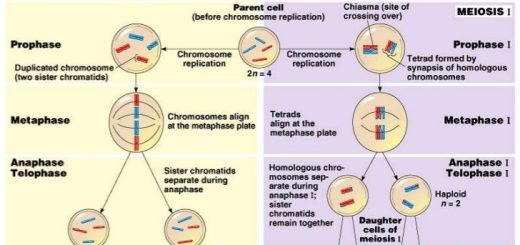Gene mutations types, causes, examples and Regulation of Gene Expression
Mutations are permanent changes in a DNA sequence, this altered DNA sequence can be reflected by changes in the base sequence of mRNA, and sometimes, by changes in the amino acid sequence of a protein, mutations can cause genetic diseases.
Types of mutations
1- Point mutation (single base substitution)
It may be:
- Transition: In which one purine is replaced by another purine or one pyrimidine is replaced by another pyrimidine. (e.g. A⇔G or C⇔T)
- Transversion: In which a purine is replaced by a pyrimidine or a pyrimidine is replaced by a purine. (e.g. T⇔A T⇔G, C⇔A C⇔G)
Changing a single nucleotide base on the mRNA can lead to any of the three results:
- Silent mutation: The codon containing the changed base may code for the same amino acid, for example, if the serine codon UCA is given a different third base (to become, say, UCU), it still codes for serine, therefore, this termed a silent mutation without any effect on the protein structure.
- Missense mutation: The codon containing the changed base may code for a different amino acid, the substitution of an incorrect amino acid may result in three variable effects on protein structure (e.g. hemoglobin β-chain).
a- Acceptable missense mutation
AAA → AAU (codons)
Lysine → Asparagine (amino acid) 61 (apparently normal functional hemoglobin)
b- Partially acceptable missense mutation
GAA→ GUA (codons)
Glutamic acid → Valine (amino acid) 6 (Hb S; it can bind and release O2 although abnormal).
c- Unacceptable missense mutation
CAU → UAU (codons)
Histidine → Tyrosine (amino acid) 58 (Hb M; it cannot transport O2). - Non-sense mutation: The codon containing the changed base may become a termination codon, for example, if the serine codon UCA is given a different second base (to become, say, UAA), the new codon causes the termination of translation at that point, this results in protein which is shorter than normal and is usually non-functional.
2- Frameshift mutation
It results from the deletion (removal) or insertion (addition) of one or more nucleotides in DNA that generate altered mRNAs with different effects on protein structure.
Regulation of Gene Expression
Types of Gene Expression
- Constitutive gene expression is the unvarying expression of a gene, it is responsible for the expression of House Keeping genes, these are genes for products that are required at all times, they are expressed at a more or less constant level in every cell of an organism, e.g. genes for the enzymes of central metabolic pathways, such as citric acid cycle.
- Regulated gene expression is the expression of genes in which the cellular level of their products varies in response to molecular signals, they are called inducible genes or repressible genes.
Inducible genes are the genes which their products increase in concentration under particular molecular circumstances. Repressible genes are the genes which their products decrease in concentration in response to molecular signals, the process of decreasing their expression is called repression, i.e.; negative regulation.
Regulation of Gene Expression in Eukaryotic cells
I- Gene Loss
- If the genes are completely or partially deleted from the cells, functional proteins can’t be produced
- E.g: during the development of the red blood cells.
Immature erythroblasts contain nuclei that produce mRNA for the globin chain of hemoglobin, as the cells maturate, the nuclei are extruded, so that the fully mature red blood cells have no genes, so they can no longer produce mRNA.
II- Transcriptional Regulation
DNA regulatory region
Each gene can be divided into coding and regulatory regions, as defined by the transcription start site. The coding region contains the DNA sequence that is transcribed into mRNA, which is translated into proteins. The regulatory regions consist of two classes of elements:
(A) Basal expression elements consist of the proximal element of the TATA box that direct RNA polymerase II to the correct start site (+1) and the upstream element e.g. CAAT box or GC box that specifies the frequency of initiation.
(B) Regulated expression elements: (Cis-acting elements): They are specific DNA sequences that are present on the same gene, so-termed Cis-elements, and are responsible for the regulation of expression, they can exert their effect on transcription even when separated by thousands of base pairs from a promoter, they include the following elements:
- Enhancers are Cis DNA elements that facilitate or enhance initiation of transcription at the promoter, they interact with gene regulatory proteins or trans-factors (so termed because they are produced by other genes) and increase the rate of expression.
- Silencers interact with gene regulatory proteins or trans-factors and decrease the rate of expression.
- Other regulatory elements mediate response to various signals including hormones called hormone response elements (HRE), chemicals, and metals.
III- Post-Transcriptional Regulation:
Regulation can occur during the processing of the primary transcript (hnRNA) and during the transport of mRNA from the nucleus to the cytoplasm.
- Alternative splicing and polyadenylation sites: Processing of the primary transcript involves the addition of a cap to the 5´-end, removal of introns, and the addition of poly(A) tail to the 3´-end (polyadenylation) to produce mature mRNA. In certain cases, the use of alternative splicing and polyadenylation sites causes different proteins to be produced from the same gene, for example, in parafollicular cells of the thyroid gland, the calcitonin gene produces mRNA that codes for calcitonin.
- RNA editing: It is the processing of RNA in the nucleus by enzymes that change a single nucleotide either by insertion, deletion, or substitution, an example of RNA editing occurs in the production of β apoprotein (apoβ) that is synthesized in the liver and intestinal cells and serves as a component of the lipoproteins, although these apoproteins are encoded by the same gene, the version of the protein made in the liver (B-100) contains 4563 amino acid residues, while the (B-48) made in the intestinal cells has only 2152 amino acid.
IV- Regulation at the level of Translation:
Most eukaryotic translational controls affect the initiation of protein synthesis, the initiation factors for translation, particularly eukaryotic initiation factor 2(eIF2), are the focus of these regulatory mechanisms, the action of eIF2 can be inhibited by phosphorylation.
V- Post-Translational Regulation:
After proteins are synthesized, their lifespan is regulated by proteolytic degradation, proteins have different half-lives, some last for hours or days, others last for months or years, some proteins are degraded by lysosomal enzymes, other proteins are degraded by proteases in the cytoplasm. Some of these proteins appear to be marked for degradation by attachment to a protein known as ubiquitin, ubiquitin is a highly conserved protein, there is very little variation in its amino acid sequence between organisms.
Gene mutations types, causes, examples & Regulation of Gene Expression
DNA Repair types, definition & importance, Protein Biosynthesis & Genetic Code
DNA replication steps & rules, DNA polymerase enzymes & RNA primer synthesis
Structure of nucleic acids, Deoxyribonucleic acid (DNA) & Ribonucleic acid (RNA)
Importance of Nucleosides, Nucleotides, Purines, Pyrimidines & Sugars of nucleic acids
Tissues types, Epithelial tissue features, Covering & Glandular Epithelium



